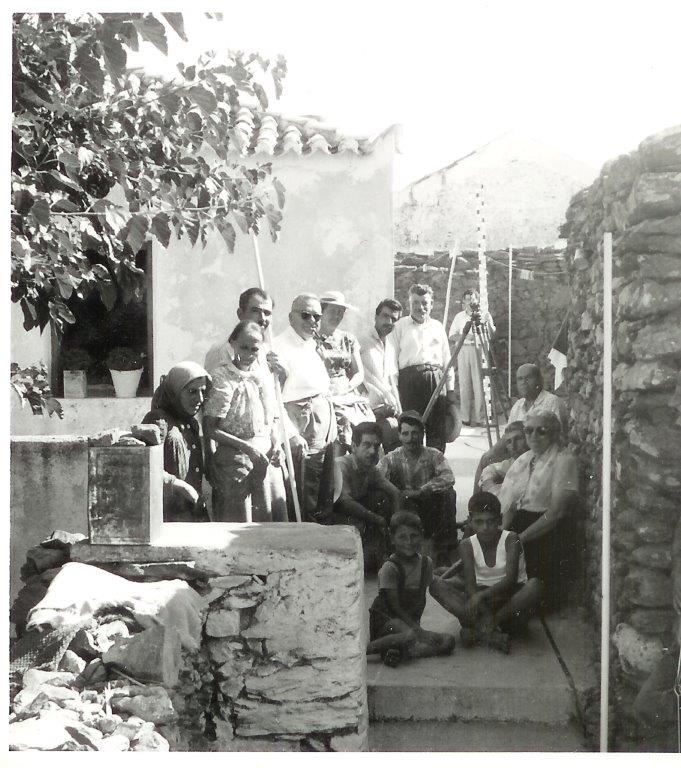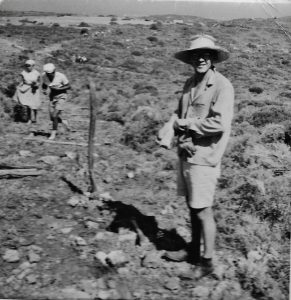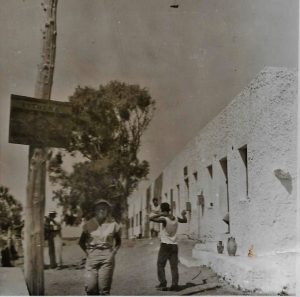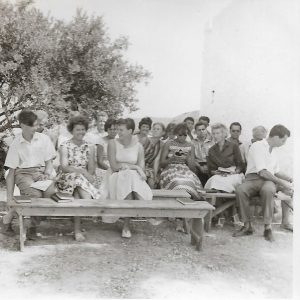Text is also published in the Kythera Summer Edition 2010.
Activities at Kythera of the World Council of Churches Team-Kythera from May 1960 thru September 1971.
*another interesting read about the springs on the island in general and particular in Mylopotamos from European Union of Geosciences ( EGU)
Water and Trees: 1960, still an issue nowadays
Kythera is still more or less a self dependent agricultural island with only a weekly boat connection from Piraeus when Jurjen Marten (George) Koksma (1907-2004) and his wife Anna Lagendijk (1911-1993) arrive by the end of April 1960 at Kapsali. They are being welcomed by Bishop Meletios who had asked the World Council of Churches in Geneva for any assistance they could provide to help him to improve the conditions of life on the island.
Mr. Koksma is architect and civil engineer in Holland and on request of the WCC had been to Kythera the previous year to investigate and discuss this matter with Bishop Meletios.
Early 1960 the WCC offers George and Anna Koksma a contract of US $ 30,- each per month living allowance (1 US $ at that time was 30 drachmas), they agreed and packed everything to be sent by boat to Kythera for an indefinite period of time. With a fully loaded station-wagon they themselves drive to Greece.
Both George and Anna are members of a rather conservative section of the Protestant Church in Holland and speak Dutch, English and German, but do not speak one word of Greek and are dependent on interpreters. They find in Chora very old Dr. Kassapis and Mr. Altanis, teacher gymnastics, who both speak fluently German, willingly to act as such. Fortunately also the Bishop speaks very well German and the first 3 months they are quests in his household and have nearly every evening contact with the Bishop. After that they move to a larger rented house opposite the agora in Chora, where through the following years they also had their office.
Already in their first month at Kythera George and Anna learn the meaning of “siga, siga” and that time and distance have quite another meaning to a lot of Kytherians. In October they learn that as soon as the olive picking season arrives it will be very difficult to find labours to do other work.
Immediately they are confronted with the lack of water on the island, no community water supply available, people have to take water from the village wells for public use, or from the wells inside the houses, for drinking and cleaning. This water is not always to be trusted and did cause sometimes illnesses. Rainwater is running straight to the sea, slopes of the hills are bare, not having a vegetation to retain the running water to allow a soaking into the soil.
The solution for the drinking water problem is to provide the villages with a sound water supply system: a cistern on a high location above the village and a closed pipe system to the houses. But where had the water to come from and how could you pump it into a cistern if there was no electricity? For the pipes was an answer, namely letters to Holland, to a plastic pipe fabricator who was willingly to donate a certain length of these pipes. But they, as well as the Greek authorities for official approval on the projects, wished to see surveys and technical layouts.
The most immediate problem however was, where did you find a spring with sufficient water all through the year and of a drinking quality? So a search was started by the Team and responsible local people at many places on the island and around a lot of villages. Not always there was agreement by the (rich) owner of the property where enough water was found, that this also could be used for the community. Also some villages had their own ideas how to do the layout and construction, and so disregarding the instructions of the governmental hydrologist from Athens (his overall report about the water situation was discussed in Chora in the town hall on September 22). In such a case the Team could not give any assistance. A lot of time was spent in sometimes very heated discussions to find a workable solution. But it was decided that Karavas (early in July), Logothetianika (mid of July) and Potamos (end of November) were going to be the first villages to be surveyed for a real community water supply. The actual surveys were done by George and Anna (!) and of course with some help of local people. In December 1960 the required technical drawings and pipe diameter design were prepared by George and sent to Holland.
>>Interesting read about the water supply system in several villages all over the island

Early October the chief forester for Kythera arrived from Athens. He investigates the situation of the meandering rivers at Paleopolis. His advice is to cover the mountain slopes with thick bushes, to build dams higher up the river and to widen the river bed to accommodate a heavy water flow after torrential rainfall. This of course is an advice valid for all over the island.
Already early August an Australian-Greek gentleman had offered ₤ 10.000 (!?) for a dam near Mitata!
Of course there was a local governmental forester stationed on the island. His name was Yannis Zerlendes. But he had not enough budget and no means of transportation. Here the Team could help very well with money to start tree nurseries and when they got an old Willys jeep from the WCC Team Ioannina in October, Yannis could use this jeep so often, that people thought the jeep was his. When it came to select places where to plant the tree saplings, some villages did not see the need of planting trees and goat keepers where just outrageously opposed.
By the end of May the Bishop asks Mr. and Mrs. Koksma for their opinion on the hospital at Potamos and to make a study of all possible improvements. At that time according the Bishop the staff did not match the requirements they should have as doctors and the building itself was not suited for its purpose. The lack of enough clean water only made all problems worse. One month later the Bishop had already taken care to get a new staff from Athens and had ordered two engineers to come down and inspect the faults of parts of the building. Mr. Koksma wrote a letter to Philips, Holland, asking for a X-ray apparatus for the hospital which was favourably answered in October. In August Mrs. and Mr. Koksma (some people wonder why Mr. Koksma himself is doing such manual work!) themselves start painting the hospital bedroom furniture. In his work diary he writes that within six weeks thanks to the Bishop the appearance of the hospital has changed from a worn out place to a decent house. Improvement plans for the layout of the hospital are presented by Mr. Koksma in September.
In May the Team was informed to make preparations and find lodgings for an international summer camp coming August in Myrtidia. Young people (male and female) from various countries such as America, Pakistan, Holland and also from Greece would arrive to do some work. What work? Erecting a fence to keep the goats away from young trees still to be planted at Myrtidia. Kytherian youth was going to help in the kitchen. The organisation to find lodging and to collect enough digging tools, wooden poles, cement and sand and barbed wire therefore could start early. When the summer camp people arrived early August, they were mightily amazed that they could start right away the following day, they had had quite other experience at other projects! The work progressed so well that some of them were brought to Mitata to work on the foundation for the first water retaining dam and a couple of them went to the hospital in Potamos to help painting the hospital room furniture. Both the works for the fence (August 4) and the dam (August 31) were blessed by the Bishop.
Following is a quote from Mr. Koksma’s weekly work diary to Geneva about his daily schedule in the middle of August concerning the summer camp at Myrtidia:
At 5.00 a.m. getting up, at 6.00 transport of the Mitata dam workers, at 6.45 transport of summer campers to Potamos doing hospital furnish painting and giving some instructions about the work, at 8.15 back to the dam, encouraging the discouraged sweating dam workers from 8.30 to 10.30, then back to the hospital and finish the painting job, at 12.45 back in Myrtidia. Washing and lunch ended at 2.00 p.m. Then a warm midday rest with much flies. At 3.30 p.m. another journey started. For the summer campers Lysol, paper and bread from Chora, if no bread anymore, we had to go to Karavas! To Pitsinianika for eggplants, courgettes, pears or grapes, tomato’s and onions. We should not forget the salt and sugar! Eggs from Livadi. Be back for dinner and remember the bible study at 6.30. And, oh yes, toilet paper, macaroni, medicines against diarrhoea and the mail. The mail, the mail, the mail! And please, the spirit and the olive oil is finished and oh, Mr. Koksma, I am dying for just a tiny bit of chocolate. And haven’t they got tomato ketchup and spam or at least a decent salami? And wait a minute, what do you say? The meat?! Yes, sure I’ll remember. Yes and soap as well, yes, yes, nails and wire, wood and a saw, a bar and, and, and … so on.

Apart from a tremendous lot of correspondence, planning finances and budgets, translations for his Grace the Bishop in this first year 1960, many other things were (partly) started or thought to be necessary for the island at some later time: staking out part of the road from Alexandrades to Paleopolis and the road from Drimona to Myrtidia, a road around Chora (future), rural water supplies at various villages, sewerage and refuse problems (future), airstrip at Frilingianika (future), Artesian well drilling, plans or layouts for hotels, houses, 7 stables, the rural school for girls in Mylopotamos (future), articles in a local newspaper to inform the Kytherians about the activities and possibilities of the WCC Kythera-Team and their own Kytherian part in it, and so on and so on.
Following is a quote from Mr. Koksma’s weekly work diary (1960, October 7) to Geneva about a conversation he had with Mr. Altanis:
– People are asking “what does this Koksma-fellow really do here?” They do not see anything but us touring all over the island, but still no trees, still no water and still no gold laying on the streets.
-And people say “sure, sure Mr. Koksma, cooperation, bringing the people together once more. That is right. Bundling of power, just what you say. Exactly!”
But as soon as they can, they execute your proposals behind your back. Without you.
To this Mr. Altanis, teacher, answers:
– “does not matter who does. Only this is the fact: now that Mr. Koksma has come to the island, now everyone starts doing something as quick as he can”, and explains that even when people oppose to the team’s proposals, but start doing something, that this in it self is a result of the Team’s being at Kythera.
Jean Bingen
May 2010, former team member in various years.
Fatsadika, Kythira, Greece.
Maassluis, The Netherlands
Below summer camp photos, click on a photo to enlarge.













